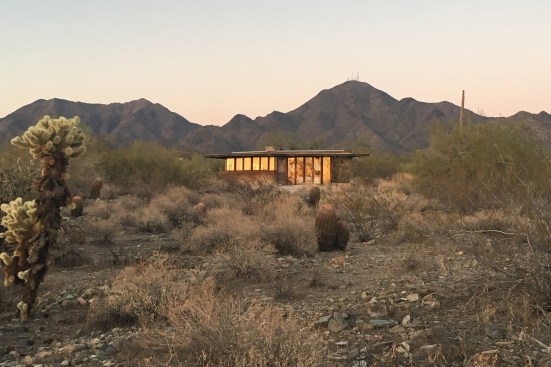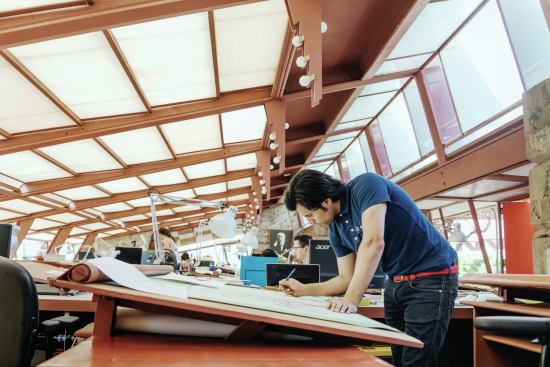The ongoing struggle by students and other supporters to save the School of Architecture at Taliesin took another turn late last week when the school’s board reversed its earlier decision to close the small, unique institution that Frank Lloyd Wright founded and considered a key part of his legacy.
The announcement has given supporters a glimmer of hope, but the school’s fate still rests with its de facto landlord, the Frank Lloyd Wright Foundation. The boards of the two institutions have been engaged in a public spat about whether the school can financially sustain itself, and the school board made the decision to close after negotiations with the foundation appeared to offer no hope for survival.
In a response to the school board’s reversal, the foundation released a statement in which it seemed far more interested in attacking the board than reconsidering the school’s closure. Without a change of heart by the foundation, the school remains scheduled to close at the end of the term this spring.
Dan Schweiker, chair of the school’s board of governors, says the board had decided to reverse its original Jan. 25 decision to close the school both because of an outpouring of public support and because it had secured additional revenue streams.
In an interview with ARCHITECT, Schweiker said that financial support includes a commitment by Qingyun Ma, the former dean of the University of Southern California School of Architecture who is now affiliated with two architecture schools in China, to send the graduate school in Taliesin between six and 12 new students from China, who would meet all entrance requirements and pay full tuition. The additional students would significantly improve the balance sheet of the school, which currently has 25 full-time students.
The Taliesin Fellows, an alumni group, also pledged to raise $500,000 by April 30 to keep the accredited architecture program open, Schweiker added, with the promise of more fundraising in the future. “We were financially solvent before this, and we had the money to keep going forward,” Schweiker said, “but this really allows us to go forward.”
“Everything I know about Frank Lloyd Wright’s desire for the future was to have the foundation support the school, and we do not feel that love from the foundation,” he said. “But that’s yesterday. Tomorrow, I would love for us to be best friends. All I’m asking for is the foundation to sit down and negotiate with us.”
Schweiker noted that a passionate campaign by the students to save their school also weighed upon the board’s decision. The students published a statement in which they spoke about their personal connection to Taliesin and the value of its unique educational model. The institution is widely known for its student-designed shelters that populate the desert landscape at Taliesin West—an embodiment of Wright’s belief in hands-on-education and organic architecture. The students also started a Change.org petition to save the school that, as of March 11, had more than 15,000 signatures. And several students testified about the school’s significance and personal meaning to them at a hearing of the Arizona State Board for Private Postsecondary Education.
The public response to news of the school’s closure has extended beyond the student body. “We’ve been hearing from architects all over the country and internationally, (saying), ‘You can’t let this happen; you have to find a way to keep this school going,’” Schweiker said. “It was an unbelievable outcry . . . It was so overwhelming that how could we not do everything we possibly could to keep the school open?”
Schweiker acknowledged the contentious relationship with the foundation before expressing his hope it could still be worked out. “Everything I know about Frank Lloyd Wright’s desire for the future was to have the foundation support the school, and we do not feel that love from the foundation in any way shape or form,” he said. “But that’s yesterday. Tomorrow, I would love for us to be best friends. All I’m asking for is the foundation to sit down and negotiate with us. Just come to the table with us and let’s talk.”

Lorraine Etchell
Japanese House, one of the student shelters at Taliesin West
The how and why of the original decision to close the Taliesin school has been the subject of a bitter dispute between the two boards. Wright created the foundation to support the school, but the two have been separate corporate entities since 2017. The foundation holds title to Wright’s former residences–Taliesin near Green Spring, Wisc., and Taliesin West, outside Scottsdale, Ariz.—that serve as the school’s campuses. The memorandum governing that tenancy expires this summer.
When it first voted to close, the school board said the foundation’s demand that the school give up accreditation, along with other stipulated changes, made it impossible to stay open. The foundation, in turn, contended the school could not come up with a sustainable, long-term financial plan to support itself and refused the foundation’s offer to continue operations for another year or two.
In its latest statement, the foundation doubled down on its position, blaming the school board for the fallout since its decision to close. “The School’s announcements and lack of planning for the consequences of its earlier decision have adversely affected the lives of its employees who were terminated, generated distraction for its students from their studies and future planning, upset its alumni community, and disrupted the Foundation’s own important work,” the statement said. “The board has demonstrated more concern about seeking blame for its decision to close than creating a sustainable business model for itself.”

Mark Peterman
Students at the School of Architecture at Taliesin, formerly called the Frank Lloyd Wright School of Architecture
Outgoing school president Aaron Betsky (an ARCHITECT contributor), told the magazine that the foundation’s statement was “complete bullshit, and they know it.” Betsky said the school prepared separate budgets in case the school was forced to close this year and in case it could have continued operations over a longer period of time. Those budgets, he said, “have been gone over with a fine-tooth comb.”
Betsky said that Graff has refused to acknowledge the school’s efforts to achieve financial stability and continues to insist falsely that the school hasn’t put together or submitted feasible plans. “They have made nothing but insinuations and difficulties for us, and they have been not very helpful at all,” he said. “I think Mr. Graff should look to himself and his own planning rather than accuse the school of a lack of planning.”
The foundation, as with ARCHITECT’s previous story, refused a request for an interview with Graff or another foundation representative. Previously, Graff has said he believes in the school. “Give me a sustainable model, I’m there,” he told Architectural Digest.
But Taliesin students have charged that the foundation’s leaders seem to consider them a nuisance or worse, have dismissed their importance, shown little interest in their work, and recently placed restrictions on their ability to showcase the school by halting shelter tours and taking the studio off the regular Taliesin West tour.
In the most troubling report, Alex Martinec, a first-year student at the school, testified before the Arizona State Board for Private Postsecondary Education that he was verbally abused by Graff after a chance encounter turned into a discussion about the importance of the students to Wright’s legacy. “In addition to being sworn at repeatedly, he told me I was no one,” Martinec told the state board. “This was the first time I met the CEO.” (Martinec, in an interview with ARCHITECT, said he filed a report on the incident with the foundation and school’s human resources department and Graff later apologized in a mediated meeting.)
“I very much fear for the Frank Lloyd Wright Foundation, which is an organization that at one point I supported very strongly, because I see its reason for being as only a hollow shell of what it used to be,” he said, “and that will be a liability for it for fundraising and other things it would like to do in the future.”
Several people familiar with the relationship between the school and the board believe the foundation is determined to rid itself of the school, believing they can make more profitable use of the spaces the school occupies. The foundation appears to think that “they can find somebody to rent the property for more than we pay them,” said Schweiker. “But I think that’s not looking at it the right way because we were part of Frank Lloyd Wright’s will, the education of students. That’s important.”
Graff has acknowledged the foundation does not have large cash reserves and borrows money in the summer when there are fewer visitors to the site. The foundation said in its latest statement that it has received interest from other educational institutions in operating programs at Taliesin and Taliesin West, and looks forward to developing new educational efforts true to Wright’s vision.
Meanwhile, former students and school leaders have joined the current board in calling on the foundation to sit down with the school and work on finding common ground to keep it open. Victor Sidy, who served as dean of the school from 2005 to 2015, said, “I’m stunned at the lack of proactive leadership by the foundation to solve this problem.”
Sidy believes the foundation’s position could come back to haunt it. “I very much fear for the Frank Lloyd Wright Foundation, which is an organization that at one point I supported very strongly, because I see its reason for being as only a hollow shell of what it used to be,” he said, “and that will be a liability for it for fundraising and other things it would like to do in the future.”
